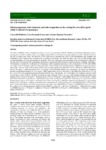Use este identificador para citar ou linkar para este item:
http://www.alice.cnptia.embrapa.br/alice/handle/doc/1052368| Título: | Soil management, seed treatment and soil compaction on the sowing furrows affect grain yields of upland rice genotypes. |
| Autoria: | PINHEIRO, V.  STONE, L. F.   NASCENTE, A. S.   |
| Afiliação: | VENERALDO PINHEIRO, CNPAF; LUIS FERNANDO STONE, CNPAF; ADRIANO STEPHAN NASCENTE, CNPAF. |
| Ano de publicação: | 2016 |
| Referência: | Australian Journal of Crop Science, v. 10, n. 8, p. 1112-1117, 2016. |
| Conteúdo: | The water availability for flood irrigated rice (Oryza sativa L.) is decreasing worldwide. Therefore, developing technologies to allow growing rice in aerobic condition, such as a no-tillage system (NTS) can contribute to produce upland rice grains without yield losses and also in saving more water. The objective of this study was to determine the effect of soil management, seed treatment and compaction on the sowing furrow on grain yield of upland rice genotypes. We made two trials, one in an NTS and another using conventional tillage, CT (one plowing and two diskings). The field experiments were performed in the Central Region of Brazil in Cerrado soils. For each trial, the experimental design was a randomized block design in a factorial scheme, with three replications. The treatments consisted of a combination of 10 genotypes with 2 compaction pressures on the sowing furrow (25 kPa and 126kPa) and 2 types of seed treatment (with and without pesticide). Under CT, the seed treatment did not contribute to increase upland rice grain yields. However, under NTS the grain yield of some genotypes [BRS Esmeralda (from 723 to 1,766 kg ha-1), BRS Pepita (from 930 to 1,874 kg ha-1), AB072044 (from 523 to 1,579 kg ha-1), and AB072085 (from 632 to 1,636 kg ha-1) at 25 kPA soil compaction pressure, and Sertaneja (from 994 to 2,167 kg ha-1), BRS Pepita (from 1,161 to 2,100 kg ha-1), and AB072085 (from 958 to 2,213 kg ha-1), at 126 kPA soil compaction pressure] increased with the use of this practice. At CT the higher soil compaction pressure on the sowing furrow (from 25 kPa to 126 kPa) increased rice grain yield only when it was used seed treatment and the genotypes Serra Dourada (from 1,239 to 2,178 kg ha-1), Sertaneja (from 1,510 to 2,379 kg ha-1), and Cambará (from 1,877 to 2,831 kg ha-1). On the other hand, under NTS, increasing soil compaction pressure on the sowing furrow allowed for an increased rice grain yield of Serra Dourada (from 1,553 to 2,347 kg ha-1), Esmeralda (from 723 to 1,643 kg ha-1), AB072044 (from 523 to 2,040 kg ha-1), and Cambará (from 1,243 to 2,032 kg ha-1) without seed treatment and Sertaneja (from 1,385 to 2,167 kg ha-1) and AB072044 (from 1,579 to 2,356 kg ha-1) with seed treatment. In CT the most productive genotypes were AB062008 (2,714 kg ha-1) and BRSMG Caravera (2,479 kg ha-1), while at NTS were the genotypes: BRSGO Serra Dourada (2,118 kg ha-1), AB072047 (1,888 kg ha-1), AB062008 (1,823 kg ha-1), BRSMG Caravera (1,737 kg ha-1), Cambará (1,716 kg ha-1), AB072044 (1,625 kg ha-1), BRS Esmeralda (1,604 kg ha-1), and BRS Pepita (1,516 kg ha-1). |
| Thesagro: | Arroz Oryza sativa Semente Compactação do solo Manejo do solo Plantio direto Pesticida Prática cultural |
| Palavras-chave: | Sulco de semeadura |
| ISSN: | 1835-2707 |
| Tipo do material: | Artigo de periódico |
| Acesso: | openAccess |
| Aparece nas coleções: | Artigo em periódico indexado (CNPAF)  |
Arquivos associados a este item:
| Arquivo | Descrição | Tamanho | Formato | |
|---|---|---|---|---|
| CNPAF2016vp.pdf | 520,64 kB | Adobe PDF |  Visualizar/Abrir |









